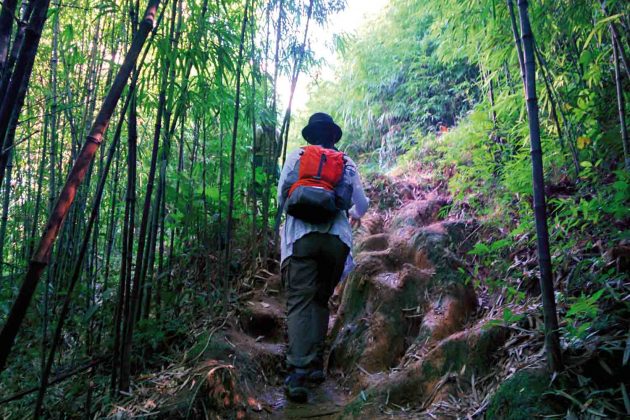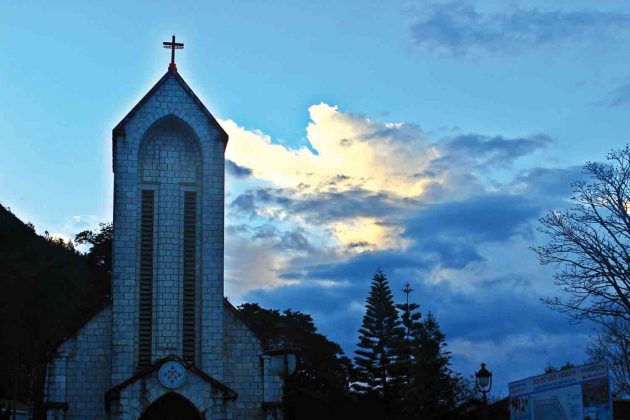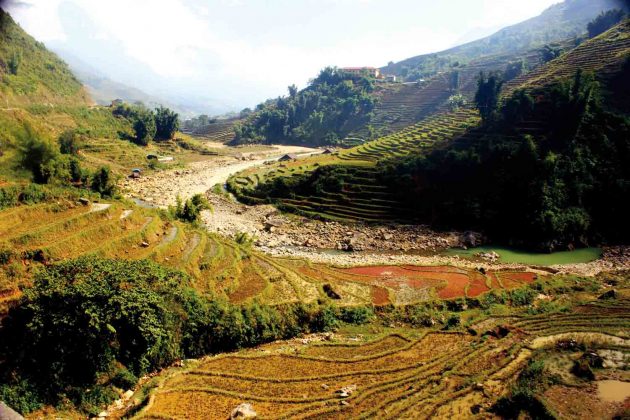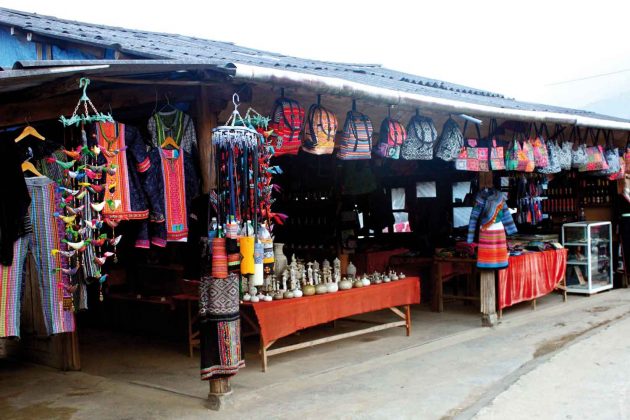The dreamlike landscape of “the Tonkinese Alps”, the enchanting culture of Sapa and its lovely, welcoming people have been dwelling on my mind ever since I returned from Vietnam. I love exploring the untold human stories, so on my trip I decided to sneak a peek into the lives of ethnic tribes of Sapa. This article is an attempt to look beyond the surface and discover the true beauty of Vietnam.
I saw the first glimpse of Sapa on television and the idea to visit Vietnam took birth in my mind. Three months later, I was in the quaint land of mist and mountains. I reached Sapa early in the morning after a comfortable five hours Hanoi-Sapa journey in a bus. The moment I alighted from the bus, I noticed a flock of short Hmong women dressed in vibrant traditional outfits smiling and asking if I needed a guide. I politely declined and took a taxi to the Holy Rosary Church, alias the Stone Church.
The centre of the town was dwarfed by mountain ranges and especially the peak of Phan-Xi-Pang [Vietnam’s highest mountain at 3,100m]. The Stone Church was built in late 19th century by the French and stood tall in this orient-meets-the-alps retreat. Across the Church stood the town’s main marketplace and plaza.
The exploring begins
During the trek after a hearty buffet breakfast at Cinnamon restaurant, my soft spoken, ever smiling, traditionally clad guide Si told me that Sapa has numerous ethnic minority groups namely Hmong, Dao, Giay and Tay and majority [about 80 per cent] of the population is into agriculture.
Paying attention to Si’s words only partially, my eyes absorbed the jaw-dropping panoramas of the valley. The rice terraces ran down the lofty slopes and the clouds offered glimpses of high soaring peaks farther away. Bathed in morning sunlight, the misty vistas looked like giant watercolour paintings. We walked through the terraced rice paddies, Indigo fields, bamboo forests, rivulets and small waterfalls. Water buffaloes and pigs stared at us from rice fields. My muddy slip-and-slide adventure trek was both rewarding and tiring. Though it got extremely sweaty despite the cool breeze, the astounding views and the weather made up for all the hard work.
Bathed in morning sunlight, the misty vistas looked like giant watercolour paintings
Tiny Hmong women, while greeting us warmly, tried selling everything they had in their traditional woven baskets: embroidered hemp skirts, bags, belts, purses, silver bracelets, earrings and traditional necklaces. I learnt from these innocent-looking English speaking traders that looks can be deceptive; they seemed to have embraced capitalism. Talking to them meant buying their stuff. If you don’t buy, be prepared to get nasty looks. And taking their picture is a strict no-no, unless you buy their items. For them it’s simple; “No money, no picture.” I thought of them as rude and shrewd but subsequent heart-to-heart conversations I had with a few of them made me change my mind about these gentle souls struggling to survive.
Tiny Hmong women, while greeting us warmly, tried selling everything they had in their traditional woven baskets
Sapa’s unique traditions
The excruciating five-hour trek had left me drained. Huffing and puffing, we finally reached a local restaurant at the Lao Chai Village which was buzzing with tourists, its air smelling of beef and pork. The waitresses delivered orders at lightening speed. I was hungry but unfortunately my vegetarian meal requirement was lost in the translation. So I was left with no choice but to have fruit. After a quick lunch I was once again out with my guide, discovering the little hamlet. While strolling through the village, Si told me about some of their unique traditions:
Saturday love market: On Saturday nights, Sapa’s main square turns into a dating point for young boys and girls looking for love. Historically, young girls would be singing, hidden away in the dark. If any boy liked any particular voice, he would find the young girl out, court her and follow it up with a romp in the forest for three days. If the match was on, these trips would usually end in marriage.
Marriage by kidnapping: A young man kidnaps a young woman with the help of his friends and family. He informs his new in-laws only two days after the kidnap. However, the kidnapping is symbolic only. The girl usually knows she is going to be kidnapped as she is given a gift two days in advance by the boy suggesting his motive. If she doesn’t like the match she can refuse and return to her parents’ home with any family member that comes to rescue her. If she is happy with the match, the boy’s family pays the bride’s family a price either in cash or by livestock such as buffalo to support the bride’s family from whom an earning member is taken away.
On Saturday nights, Sapa’s main square turns into a dating point for young boys and girls looking for love
Traditional medicines: Heating cardamom in a buffalo horn and pressing the hot horn onto one’s forehead cures headaches but leaves behind a circular burn like mark on the forehead.
Ethnic dressing: Each ethnic tribe in the district has a different style of dressing, but each tribe is usually responsible for weaving their own clothes by hand with the help of indigenously grown indigo and hemp. Even the jewellery they wear is self-made.
Not only had I discovered so much about Sapa in a single day, I had also experienced all four seasons: cool spring morning, warm and sunny summer afternoon, cloudy autumn evening, and a cold winter night.
The next day, our three-hour trek took me through villages, streams, rivers, waterfalls, bamboo forests and muddy pathways. Soaring mountains and deep valleys dwarfed the bamboo villages, dirt roads and terraced rice fields. I realised that I was enjoying the view more today. Perhaps because I didn’t feel like a tourist anymore. I connected with the locals and was no longer annoyed by the pesky behaviour of the sellers.
The soaring mountains of Northern Vietnam have long preserved the unique cultures of ethnic hill tribes but today this strength has become their weakness. While the rest of Vietnam has started enjoying the benefit of globalisation, Sapa has remained the poor cousin being marginalised and forgotten. Although in the last 10 years Sapa has become a darling of tourists arriving in Vietnam, the local tribes have hardly benefited from this travel boom. It is the rich tour operators from Hanoi and Ho Chin Minh who have made all the moolah.
Only time will tell if these tribes will survive. But someday, I hope and pray, that their effervescent smiles will emanate from a happy prosperous life and not from a life of poverty, struggles and compromises.
Good to know
Location: Lao Cai Province, near the China border in north-west Vietnam. 350km north-west of Hanoi.
Getting There: There are private sleeper buses and overnight trains from Hanoi to Lao Chai, followed by 45 minutes drive from Lao Chai city by bus.
Visas: Vietnam offers Visa on Arrival at the airport if you get an approval letter online.
Sight-seeing: Sapa is best explored on foot but you can hire a taxi or a motorbike from the town to explore remote, far off places.
When to go: Between March and May or October and November. Winters are cold and foggy with temperatures occasionally dropping below freezing point whereas summers are rainy. Sapa during weekdays is quieter and reasonable as compared to weekends when tourists flock to Hanoi to visit the Saturday market.
Where to stay: Sapa is a tourist magnet so a lot of good hotels huddle in the main town. There are also traditional homestays in villages like Lao Chai, Ban Ho, Ta Van, Ta Phin. Those with limited budget can opt for hostels like Sapa Backpackers, Mountain View, Go Sapa Hostel among others.
What to buy: The livelihood of the tribes depends on the money they make by selling their handmade items to tourists. Be generous. Buy their handicraft. They are unique and cheaper than what you’ll find in showrooms in Sapa and Hanoi.
What to see: Thac Bac [Silver] waterfall, Ham Rong Mountain, Rattan Bridge, Bamboo Forest and Ta Phin Cave among others. Trekking is an ideal way to explore Sapa’s enchanting beauty.
- Photos: Archana Singh
This feature was first published in the February 2016 issue of Complete Wellbeing.










